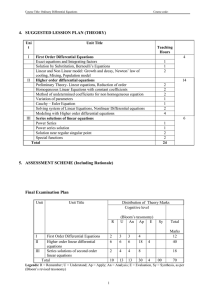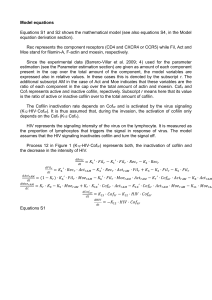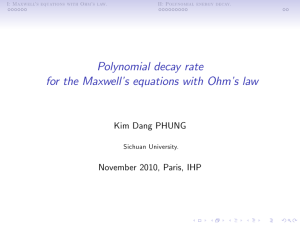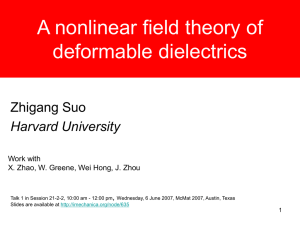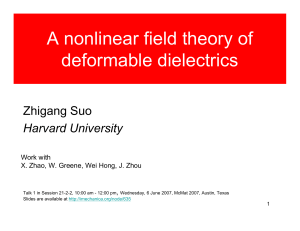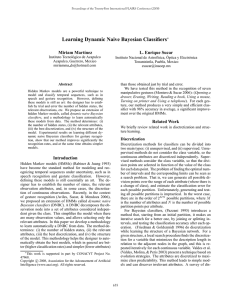Computational Methods in Geophysical Electromagnetics Eldad Haber
advertisement
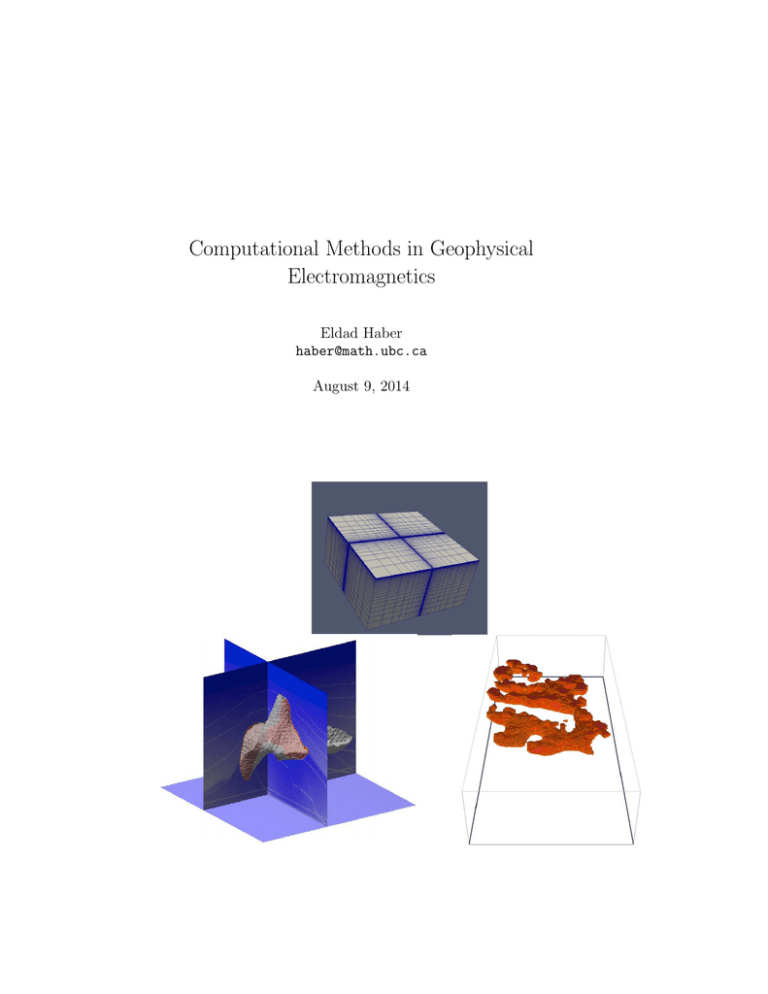
Computational Methods in Geophysical Electromagnetics Eldad Haber haber@math.ubc.ca August 9, 2014 2 Contents Preface 1 2 9 Maxwell’s Equations and their geophysical applications 1.1 Di↵erent representations of Maxwell’s equations . . . . . . . . . 1.1.1 Maxwell’s equations in time and frequency . . . . . 1.1.2 Integral form of Maxwell’s equations and interface conditions . . . . . . . . . . . . . . . . . . . . . . . . 1.1.3 The equations in weak form . . . . . . . . . . . . . . 1.2 Dimensional Analysis and Geophysical Experiments . . . . . . . 1.2.1 Elliptic case - Statics with magnetic sources: Magnetics . . . . . . . . . . . . . . . . . . . . . . . . . . 1.2.2 Statics with electric sources: Direct Current and Magnetometric Resistivity . . . . . . . . . . . . . . . 1.2.3 Parabolic approximations: Quasi Static regime and electromagnetic induction . . . . . . . . . . . . . . . 1.2.4 Hyperbolic regime - Ground Penetrating radar and Radio Imaging . . . . . . . . . . . . . . . . . . . . . 1.2.5 Frequency dependent conductivity and Induced Polarization . . . . . . . . . . . . . . . . . . . . . . . . 1.3 Electromagnetic fields, Sources and the EM coupling problem . 1.4 Some useful analytic solutions . . . . . . . . . . . . . . . . . . . 1.4.1 DC resistivity over a uniform earth . . . . . . . . . . 1.4.2 Magnetotelluric response of a half space . . . . . . . 1.4.3 The frequency response of a half space to a magnetic dipole . . . . . . . . . . . . . . . . . . . . . . . . . . 1.4.4 The frequency response of full and half space to a electric dipole . . . . . . . . . . . . . . . . . . . . . . 1.5 Exercises . . . . . . . . . . . . . . . . . . . . . . . . . . . . . . . The Finite Volume method in 1D and its application to Maxwell’s equations 2.1 Deriving the discretization . . . . . . . . . . . . . . . . . . . . . 2.2 Matrix Representation . . . . . . . . . . . . . . . . . . . . . . . 2.3 Implementation of boundary conditions . . . . . . . . . . . . . . 3 11 11 11 13 14 15 15 19 20 24 24 28 29 29 29 30 31 31 33 33 35 36 4 Contents 2.4 2.5 2.6 2.7 3 4 1D in practice . . . . . . . Programmer note: Testing sources . . . . . . . . . . . The 1D MT problem . . . Exercises . . . . . . . . . . . . the . . . . . . . . . code . . . . . . . . . . . . . . . . . . . . . . The method of . . . . . . . . . . . . . . . . . . . . . . . . . . . . . . . . . fictitious . . . . . . . . . . . . . . . . . . Finite Volume Discretization in 3D 3.1 Discretization of di↵erential operators on a tensor mesh 3.2 Inner Products on tensor mesh . . . . . . . . . . . . . . 3.2.1 Cell center inner product . . . . . . . . . . 3.2.2 Face variables inner product . . . . . . . . 3.2.3 Edge variables inner product . . . . . . . . 3.3 Discretization on logically orthogonal grids . . . . . . . 3.3.1 Di↵erential Operators . . . . . . . . . . . . 3.3.2 Computation of inner products . . . . . . . 3.4 Programming the operators using Kronecker products . 3.4.1 Programming Linear Di↵erential Operators 3.4.2 Programming the inner product matrices . 3.5 Exercises . . . . . . . . . . . . . . . . . . . . . . . . . . . . . . . . . . . . . . . . . . . . . . . . . . . . . . . . . . . . . . . . . . . . . . . . . . . . . . . . . . . . . . Discretization of Maxwell’s equations 4.1 Discretization of Maxwell’s equations in frequency . . . . . . . . 4.2 Statics . . . . . . . . . . . . . . . . . . . . . . . . . . . . . . . . 4.3 Programming Maxwell’s equations . . . . . . . . . . . . . . . . . 4.4 Setting up sources . . . . . . . . . . . . . . . . . . . . . . . . . . 4.4.1 Mathematical models of the sources and receivers . 4.4.2 Direct discretization of the sources . . . . . . . . . . 4.4.3 Primary secondary discretization . . . . . . . . . . . 4.5 Time stepping . . . . . . . . . . . . . . . . . . . . . . . . . . . . 4.5.1 A (very) quick review of methods for time dependent ODE’s . . . . . . . . . . . . . . . . . . . . . . . . . . 4.5.2 Discretization of Maxwell’s equations in time . . . . 4.5.3 Initialization of the Magnetic fields and their divergence . . . . . . . . . . . . . . . . . . . . . . . . . . 4.5.4 Exponential integrators . . . . . . . . . . . . . . . . 4.6 Solving the linear systems . . . . . . . . . . . . . . . . . . . . . 4.6.1 The ill-conditioning of the discrete Maxwell system 4.6.2 Iterative solvers and the discrete Helmholtz decomposition . . . . . . . . . . . . . . . . . . . . . . . . . 4.6.3 Solution using direct solvers . . . . . . . . . . . . . . 4.7 Example - modeling magnetic loop in conductive media . . . . . 4.7.1 Source generation . . . . . . . . . . . . . . . . . . . 4.7.2 Calculation of the data . . . . . . . . . . . . . . . . 4.7.3 The data from a block in a half-space . . . . . . . . 4.8 Exercises for Maxwell’s simulation . . . . . . . . . . . . . . . . . 37 38 41 43 45 45 49 49 49 50 50 54 56 60 61 63 64 67 67 68 69 70 71 71 75 77 77 79 82 83 85 85 86 88 89 90 91 92 94 Contents 5 6 7 8 5 Sensitivity Calculation 5.1 The concept of sensitivities . . . . . . . . . . . . . . . . . . . 5.2 The basic sensitivity equation . . . . . . . . . . . . . . . . . 5.3 Computation of the sensitivities . . . . . . . . . . . . . . . . 5.3.1 Computation stationary linear forward problem . 5.3.2 Computation for time dependent problems . . . 5.4 Sensitivities of complex variables . . . . . . . . . . . . . . . . 5.5 Working with sensitivities in practice . . . . . . . . . . . . . 5.6 Di↵erentiating linear algebra expressions . . . . . . . . . . . 5.7 Programmer note . . . . . . . . . . . . . . . . . . . . . . . . 5.7.1 Derivative test . . . . . . . . . . . . . . . . . . . 5.7.2 The adjoint test . . . . . . . . . . . . . . . . . . 5.8 Example - sensitivities for the time domain model problem . 5.9 Exercises for sensitivity calculation . . . . . . . . . . . . . . . . . . . . . . . . . . . . . . . . . . . . . . . . 95 95 96 97 98 99 100 101 102 104 104 106 107 110 Data fitting, Regularization and Inversion 6.1 The misfit . . . . . . . . . . . . . . . . . . . . . . . . 6.2 Over-fitting and Regularization techniques . . . . . . 6.2.1 Subspace and parametric techniques . . . 6.2.2 L2 based regularization . . . . . . . . . . 6.2.3 Total variation and anisotropic di↵usion . 6.3 L1 based Regularization . . . . . . . . . . . . . . . . 6.3.1 Discretization of regularization operators 6.3.2 Hard constraints . . . . . . . . . . . . . . 6.4 Inversion through optimization . . . . . . . . . . . . . 6.4.1 First order methods . . . . . . . . . . . . 6.4.2 Gauss-Newton and Inexact Gauss-Newton 6.4.3 Bound constraints . . . . . . . . . . . . . 6.4.4 A comment about direct search methods 6.4.5 Optimization over complex variables . . . 6.4.6 Implementation . . . . . . . . . . . . . . 6.4.7 Regularization parameter selection . . . . 6.5 Inversion through inverse scale space methods . . . . 6.6 Exercises . . . . . . . . . . . . . . . . . . . . . . . . Large 7.1 7.2 7.3 . . . . . . . . . . . . . . . . . . . . . . . . . . . . . . . . . . . . . . . . . . . . . . . . . . . . . . . . . . . . . . . . . . . . . . . . . . . . . . . . . . . . . . . . . . . . . . . . . . . . . . . . . . . . 111 111 113 115 117 119 120 122 122 122 123 127 131 133 133 135 139 140 141 scale problems and problems with many sources Big data and big models . . . . . . . . . . . . . . . . . Mesh decoupling . . . . . . . . . . . . . . . . . . . . . . Stochastic methods for problems with many sources . . 7.3.1 Stochastic Hessians . . . . . . . . . . . . . 7.3.2 The stochastic gradient and Gauss-Newton . . . . . . . . . . . . . . . . . . . . . . . . . 143 143 145 148 149 150 Inversion in practice 153 8.1 Electromagnetic data set . . . . . . . . . . . . . . . . . . . . . . 153 8.2 Understanding the data . . . . . . . . . . . . . . . . . . . . . . . 154 8.3 Solving the inverse problem - first pass . . . . . . . . . . . . . . 156 6 Bibliography Contents 161



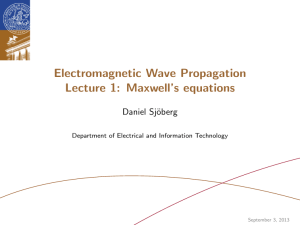
![Chem_Test_Outline[1]](http://s2.studylib.net/store/data/010130217_1-9c615a6ff3b14001407f2b5a7a2322ac-300x300.png)
